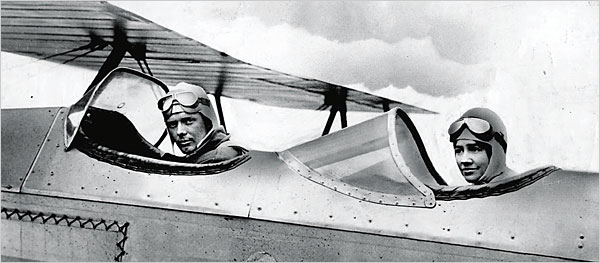The
Lindberghs

The New York Times
(Wide World Photos)
Charles and Anne Morrow Lindbergh leaving
Roosevelt Field on Long
Island in 1929.
On
July 27, 1931, Charles A. Lindbergh
and his young wife picked up an airplane at College Point, Queens,
after it had been equipped with pontoons from the Edo factory.
Contemporary news media were there in force. Mrs. Lindbergh overheard a
radio reporter tell his microphone she was wearing “a leather flying
helmet and leather coat, and high leather flying boots.” Mrs. Lindbergh
examined herself: she was wearing a cotton blouse, lightweight riding
breeches and rubber sneakers. With this and a thousand similar
anecdotes, Kathleen C. Winters, in “Anne Morrow Lindbergh: First Lady
of the Air,” shows why the Lindberghs all their lives held the
pestiferous press in loathing; it did not all start with the kidnapping
in 1932.
Winters’s short book,
both
pointed and modest, is concerned almost entirely with Anne as a figure
in aviation history. In May 1927 she had had to ask chattery classmates
at Smith College, “Who is this Lindy?” In December she met Lindbergh in
Mexico City, where her very rich father, Dwight Morrow, was the United
States ambassador. She went all googly in a week. “My little embroidery
beribboned world is smashed,” she told her diary. The next year she was
engaged to this Lindy, and in 1929 she was the wife of a leading
candidate for most famous man in the world.
Anne’s
education as a
pilot proceeded in the intervals of flying with Charles on route
surveys for budding American airline companies and attending
exhibitions in which he often starred. In 1931 Charles designated her
as radio operator, part-time navigator and relief pilot on an ambitious
route survey for Pan Am: New York to Japan and China, thence westward
around the world.
Aircraft
radio in 1931 was still primitive.
Few ground stations, and few aircraft, had radiotelephony. A flying
operator had to send and receive in Morse code and transcribe the
results while changing tuning coils in the set and adjusting a long
trailing antenna to suit the frequency in use; altogether a four-handed
job, and one a pilot alone would have found overwhelming.
The
Lindberghs’ Lockheed Sirius was a low-wing monoplane of special
elegance even for the streamlined 1930s, with tandem cockpits aft of
the wing and fuel tanks for 2,000 miles at a pop. Then as now, the
shortest route to Tokyo lay through Alaska. The Lindberghs took 10 days
from Ottawa to Nome, much of it over the population vacuum of northern
Canada, mile after mile of flat, wet nothing. At Baker Lake, trappers
told Anne she was the first white woman ever seen there. At Point
Barrow, a Scottish whaler told the Lindberghs he had not been “outside”
for 40 years; he had never seen a telephone or an automobile.
The
plane reached Tokyo after four weeks, much of it absorbed in landings
forced by impenetrable weather, usually followed by Charles’s
comforting (and often implausible) assertions that they had never been
in serious danger while descending through cloud and fog. In China the
plane was damaged in a turnover, and a cable informed them that Anne’s
father was dead; the Lindberghs returned to North America by ship.
Charles’s report to Pan Am made it clear that the technology for a
polar route was far from ready. In 1933 they undertook another survey,
exploring the Arctic route from New York to Europe. The ensuing report
was encouraging, but airline service over the Atlantic did not arrive
till 1939, just in time to be suspended by the war.
Anne
had
always aspired to be a writer, and in her 1935 best seller, “North to
the Orient,” produced a sparkling narrative that delighted both
Sinclair Lewis and Alexander Woollcott, and is deservedly still in
print. As a writer she would prosper, but as a crew for Charles she
seems to have tired of being always and everywhere “good for a woman.”
Winters, an aviation historian and a licensed pilot, reports that
Charles whistled when he wanted her attention, began to disappear and
return without prior announcement, and lectured his family on such
evils as white bread and television. It must have been trying, and she
never renewed her pilot’s license after letting it lapse in 1937.
Many
guys like me, who instinctively moon over airplanes but had to learn to
moon over gender equity, are ready to admire Anne as an aviator. For a
woman, how good was she? She was never a self-starter like Amelia
Earhart, but neither did she disappear at sea. In a pursuit that offers
endless opportunities for fatal mistakes, she made no fatal mistakes.
Charles could have had almost any pilot in the world for his second
seat, so his choice is a ringing endorsement, good enough for me.
Tom Ferrell is a former staff editor at The Times.
By TOM FERRELL
Published: February 4, 2007

Every day, we
are reminded of the importance of preserving the freedom of
flight. Not only as a tool of transportation and the ultimate means of
higher
education, but just as much for fun. Flying brings joy and a full
life for those who share this passion for
all things that strange-ly enough, fly like birds!

